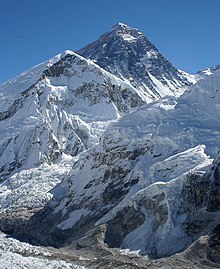South Col
| South Col | |
|---|---|
 Looking at Everest upper portions from the South Col | |
| Elevation | 7,906 m (25,938 ft) |
| Traversed by | A Swiss expedition in 1952 |
| Location | Nepal (Khumbu) China (Tibet) |
| Range | Mahalangur Himal |
| Coordinates | 27°58′30″N 86°55′55.5″E / 27.97500°N 86.932083°ECoordinates: 27°58′30″N 86°55′55.5″E / 27.97500°N 86.932083°E |
The South Col is the sharp-edged notch or pass between Mount Everest and Lhotse, the highest and fourth highest mountains in the world, respectively. When climbers attempt to climb Everest from the southeast ridge in Nepal, their final camp (usually Camp IV) is situated on the South Col. The South Col is typically swept by high winds, leaving it free of significant snow accumulation.
The South Col was first reached by Edouard Wyss-Dunant's 1952 Swiss Mount Everest Expedition that failed to reach the summit. The following year, when Mount Everest was first climbed, Wilfrid Noyce and the Sherpa Annullu were the first climbers on the expedition to reach the col. According to John Hunt, the expedition leader:
It was 2.40 p.m. Wilfrid Noyce and his companion Annullu stood at that moment above the South Col of Everest, at about 26,000 feet [7,900 m]. They were gazing down on the scene of the Swiss drama, and they were also looking upwards to the final pyramid of Everest itself. It was a great moment for them both, and it was shared by all of us who watched it. Their presence there was symbolic of our success in overcoming the most crucial problem of the whole climb; they had reached an objective which we had been striving to attain for twelve anxious days.[1]
Once on the South Col, climbers have entered the death zone – Altitude sickness is a significant threat at this elevation and can easily prove fatal. It is also difficult to sleep, and most climbers' digestive systems have significantly slowed or completely stopped. This is because it is more efficient at this altitude for the body to use stored energy sources than to digest new food. Most climbers will begin using supplemental oxygen here and have a maximum of only two or three days for making summit bids. Clear weather and low winds are critical factors in deciding whether to make a summit attempt. If weather does not cooperate within these short few days, climbers are forced to descend, many all the way back down to Base Camp. Climbers rarely get a second chance to return to the South Col in a specific expedition.
In 2005, Didier Delsalle of France landed a Eurocopter AS350 B3 helicopter on the South Col.[2] Two days later he made the first helicopter landing on the summit of Mount Everest, a feat he subsequently repeated.[3]
See also[edit]
References[edit]
- ^ John Hunt, The Ascent of Everest, Hodder and Stoughton, 1953, p. 166.
- ^ "Landing on Air". National Geographic Adventure. 1 September 2005. Retrieved 24 June 2009.
- ^ "French Everest Mystery Chopper's Utopia summit". MountEverest.net. 27 May 2005. Archived from the original on 13 January 2015.
External links[edit]
| Wikimedia Commons has media related to South Col. |



